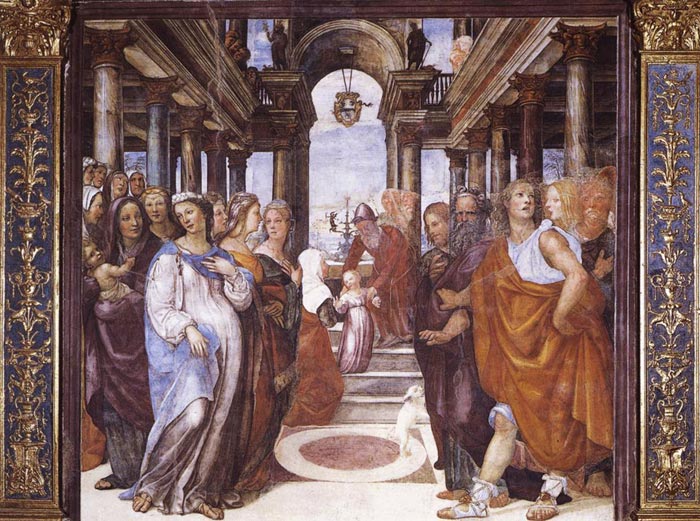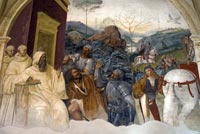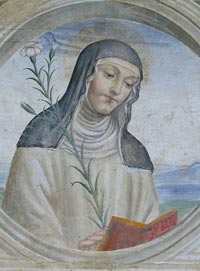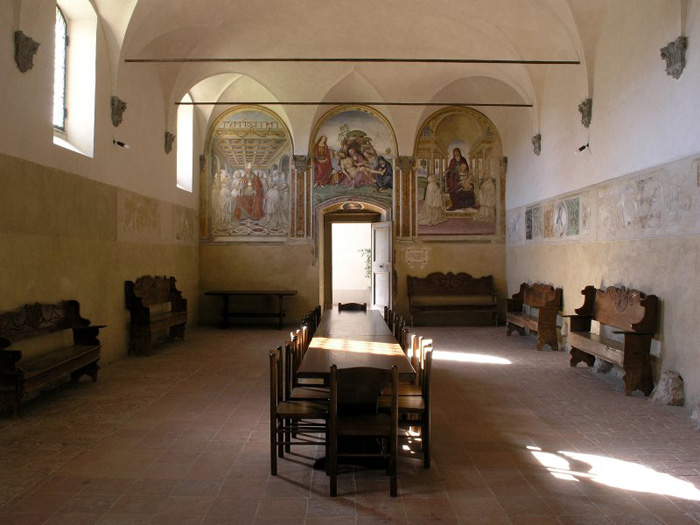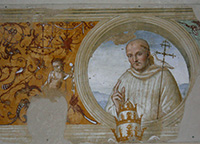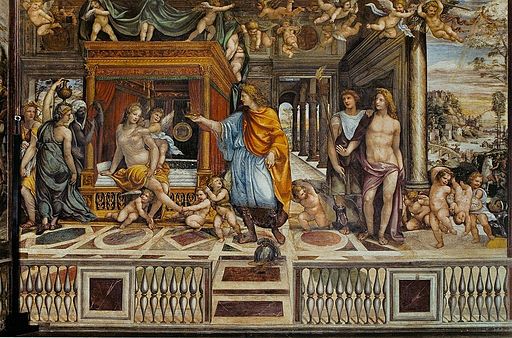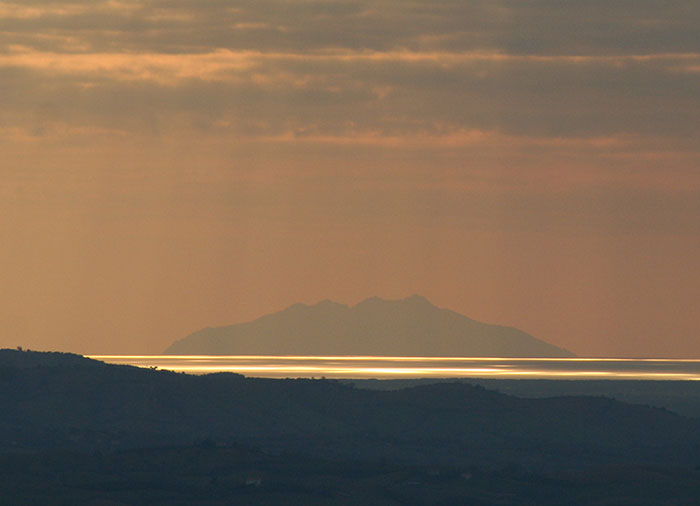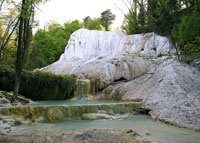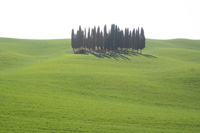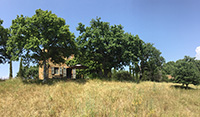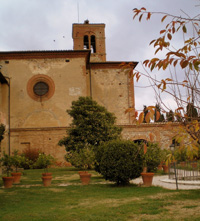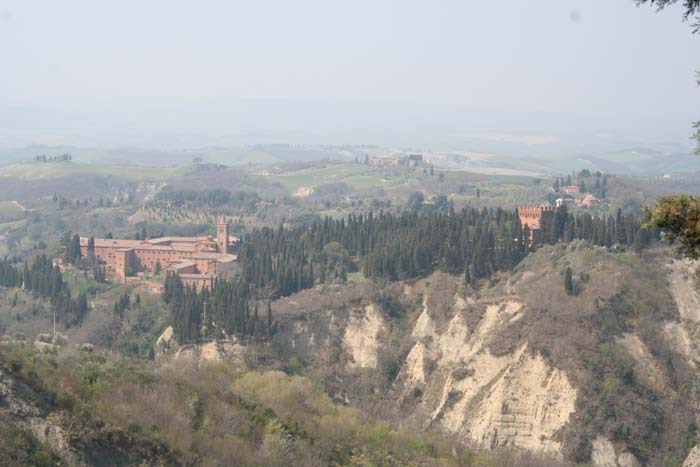| |
|
Il Sodoma (originally Giovanni Antonio Bazzi), Italian painter, whose work bridges the High Renaissance and Mannerist styles. Il Sodoma painted in a manner that superimposed the High Renaissance style of early 16th-century Rome onto the traditions of the provincial Sienese school. He spent the bulk of his professional life in Siena, with two periods in Rome. He was active chiefly in and around Siena, where he settled in 1501.
In 1503 he was given his first important commission, which was to paint in fresco the two end walls of the little convent of St. Anna in Creta, not far from San Quirico. He received twenty golden scudi in return for the six large frescoes and the row of medallions which he left there. On the shorter wall, facing the entrance, are three scenes representing the miracle of the loaves and fishes. The most important and the best preserved of these is the central one, containing the figure of Our Lord in white, with upraised fingers, blessing the five little loaves which a smiling child presents to Him.
Commissioned by Pope Julius II, Il Sodoma painted frescoes in the Camera della Segnatura in the Vatican. Raphael's frescoes afterward replaced most of his work there. For Agostino Chigi in the Farnesina Villa, Sodoma painted two frescoes, The Marriage of Alexander and Roxanne in the Tent of Darius. [1]
Vasari, who disliked him, explains the origin of his nickname the sodomite in this fashion: 'His manner of life was licentious and dishonourable, and as he always boys and beardless youths about him of whom he was inordinately fond, this earned him the nickname of Sodoma; but instead of feeling shame, he gloried in it, writing stanzas and verses on it, singing them to the accompaniment of the lute.' (Sodoma, who was married and had children) himself used the name in his signature, and Vasari's story has been questioned. Vasari also tells us that Sodoma kept a menagerie of strange animals 'so that his home resembled a veritable Noah's ark.'
He was a prolific painter of frescos and easel pictures, and he drew on a variety of sources that were not always fully digeste. Consequently his work often has incongruous juxtapositions and a general air of uncoordination, but it also possesses charm and a flair for decoration. His fresco of the Marriage of Alexander and Roxane (1516-17), painted for the Sienese banker Agostino Chigi, is often cited as his finest work. In his time Sodoma was considered the leading artist in Siena, but later critics have come to rank Beccafumi above him.
Raphael placed Bazzi very high as an artist, and painted his portrait next to himself in his famous School of Athens fresco-the figure in the white cap and gown, long said to be Perugino, but Perugino was then a much older man.
|
|
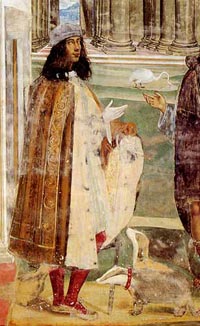 Il Sodoma, self portrait in one of the frescoes at Monte Olivetto Il Sodoma, self portrait in one of the frescoes at Monte Olivetto
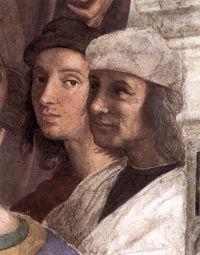
|
Among Sodomas masterpieces are the frescoes, completed in 1526, in the chapel of St. Catherine of Siena painted for the church of San Domenico in Siena, depicting the saint in ecstasy, fainting as she receives the Eucharist from an angel. In the oratory of S. Bernardino, are scenes from the history of the Virgin, painted in conjunction with Pacchia and Beccafumi (1536-1538).
|
|
The Presentation of the Virgin in the Temple, 1518, fresco, 295 x 305 cm, Oratory of San Bernardino, Siena
|
| |
The Oratory of San Bernardino, built in the 15th century on the spot where St Bernardino of Siena normally preached during his lifetime, stands on the right hand side of Piazza San Francesco, next to the church dedicated to the same saint. Born in Massa Marittima on September 8th 1380, St Bernardino (Bernardino degli Albizzeschi) dedicated himself to helping the needy from a young age, nursing the sick at the Hospital of Santa Maria della Scala.
In 1402 he joined the Franciscan Order and founded the Convento dell’Osservanza.
Today the Oratory of San Bernardino functions as a museum and is divided into two oratories one above the other. The Oratorio Superiore has wood panelling on walls and ceiling installed by Ventura Turapilli in 1496 and is decorated with frescoes by Sodoma: St Ludovico, The Presentation of Mary at the Temple, St Francis of Assisi, Visitation and Coronation of Mary.
In his painting of the Presentation, Sodoma introduced many of the lavishly attired bystanders that are characteristic of his Monteoliveto frescoes. The architectural setting for the scene, however, appears to have been influenced by Raphael's fresco of the Expulsion of Heliodorus (1512) in the Stanza d'Eliodoro in the Vatican. The paintings depicts two sets of marble colonnades seen in sharp recession, thus providing a framework and focus for an important event taking place at some distance from the spectator. In the case of the confraternity painting, this is the crucial encounter between the young child and the High Priest at the high altar, which forms the focal point of the story of the Virgin's presentation in the Temple.
|
|
|
| |
|
|
|
Deposition from the Cross
|
|
|
| |
Deposition from the Cross, 1510-13, 426 x 263 cm, Pinacoteca Nazionale, Siena
This very large painting on an arcuate panel is one of the most important works by Sodoma. Like other works by Sodoma, this painting presented numerous delaminations of the ground and paint layers.
Although generally critical of Sodoma and his work - because of his allegedly dissolute life-style - Vasari commented that this painting was considered to be one of the best that Sodoma produced.
The apparent rivalry between Sodoma and Beccafumi, already suggested in their work in the Oratory of San Bernardino and their paintings of Saint Catherine, is evident in a number of innovative altarpieces produced by the two painters for the Siena's principal churches. Although both painters were commissioned to execute altarpieces that represented the theme of the Virgin and Christ Child enthroned with saints, they also produced a series of narrative altarpieces which pushed beyond the conventional boundaries for the representation of these subjects.
The earliest of these works was Sodoma's monumental altarpiece of the Deposition of Christ. Still within its blue and gold wooden frame and with its predella, this painting is now housed within Siena's Pinacoteca and is therefore divorced from the surroundings for which it was designed. From descriptions of the altarpiece in the sixteenth-century, it seems that it was commissioned for the altar of the Cinuzzi family in the church of San Francesco, and the family's coat-of-arms accordingly appears at either end of the predella. Sodoma's altarpiece thus once stood over the fifth altar along the south wall of this barn-like mendicant church. By virtue of its imposing size, its bright and luminous colours and its clear, expressive figurative composition, the altarpiece would undoubtedly have been a striking sight in its setting.
[Source: www.wga.hu]
|
|
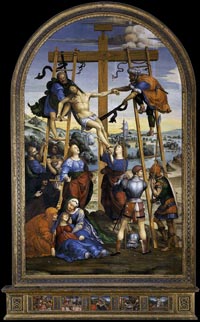
Deposition from the Cross, 1510-13, Pinacoteca Nazionale, Siena |
| |
|
|
|
Allegory of Celestial Love
|
|
|
| |
Allegory of Celestial Love, Chigi Saracini Collection, Siena |
|
|
| |
Palazzo Chigi Saracini, today the home of the prestigious Chigi Academy of Music, is a veritable treasure chest thanks to the more than 12,000 pieces assembled by Count Galgano Saracini and kept in his patrician family residence ever since.
In 1806 the nobleman Galgano Saracini opened to the public of art lovers and students at the Istituto di Belle Arti the “beautiful and superb museum” he had set up in his home in Siena, just a short distance from Piazza del Campo.
The collection is particularly rich in Italian masters, particularly of the Senese School, such as Sassetta, Sodoma, Beccafumi and Botticelli. |
|
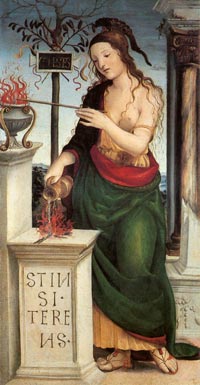
Allegory of Celestial Love, Chigi Saracini Collection, Siena
|
Among his masterpieces are the frescoes, completed in 1526, in the chapel of St. Catherine of Siena, painted for the church of San Domenico in Siena, depicting the saint in ecstasy, fainting as she receives the Eucharist from an angel.
|
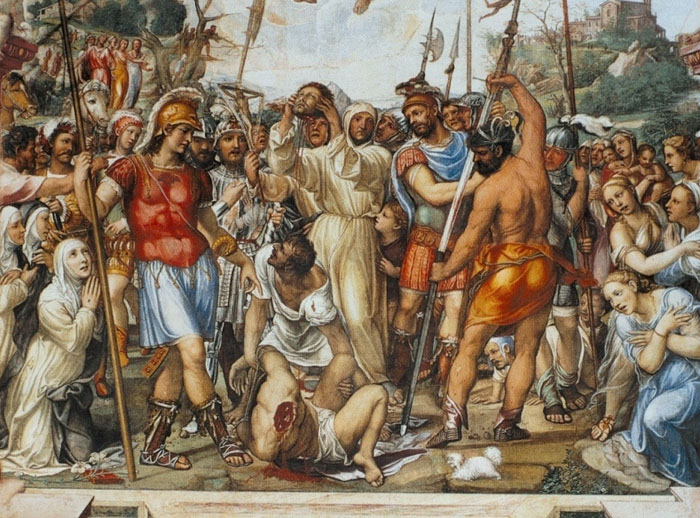 |
Il Sodoma, Execution Nicolo di Tuldo, St. Catherine Chapel, San Domenico, Siena
|
| |
The Basilica of San Domenico, also known as Basilica Cateriniana, is a basilica church in Siena, and one of the most important in the city.
The church was begun in 1226-1265, but was enlarged in the 14th century to the Gothic appearance it has now. It is a large edifice built, in bricks, with a lofty bell tower on the left (this was reduced in height after an earthquake in 1798).
St. Catherine passed a large part of her life inside the walls of this stupendous Basilica, which was one of the first to be dedicated to St. Dominic.
The St. Catherine Chapel has, in the centre, an altar housing the saint's head and thumb. Il Sodoma provided an Fainting and Ecstasy of St. Catherine and Death of Niccolò di Tuldo for the chapel, while by Francesco Vanni is a St. Catherine's Exorcism (1593-1596). The 15th century marble pavement, featuring Orpheus and animals, is attributed to Francesco di Giorgio.
The right wall has a fresco by Pietro Lorenzetti and the Adoration of the Shepherds by Francesco di Giorgio, completed by a lunette by Matteo di Giovanni and a predella by Bernardino Fungai. www.basilicacateriniana.com |
|
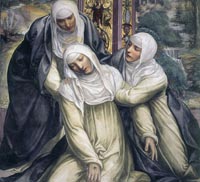 Sodoma, Saint Catherine of Siena in the Chiesa di San Domenico in Siena, 1526.
Sodoma, Saint Catherine of Siena in the Chiesa di San Domenico in Siena, 1526.
Fresco by Antonio Bazzi (il Sodoma) for the side chapel. |
| |
|
|
|
| |
|
|
|
His first important works were seventeen frescoes in the Benedictine monastery of Monte Oliveto Maggiore, on the road from Siena to Rome, illustrating the life of St Benedict in continuation of the series that Luca Signorelli had begun in 1498.
|

|
| |
|
|
Abbazia di Monte Oliveto Maggiore
|
|
|
| |
Abbazia di Monte Oliveto Maggiore was founded in 1313 by Bernardo Tolomei. An imposing square tower with a drawbridge that was part of the original defences erected to protect the entire complex stands at the entrance to the Abbey. The courtyard of the abbey opens onto a broad avenue of cypresses. To the left is the botanical garden that supplied medicinal plants for the monks. A little further on is the fish pond designed in 1553 by Pelori and used by the monks to provide fish at those times of year during which the Benedictine rule forbade the consumption of meat. The cypress avenue leads to the impressively austere, late-gothic church of the abbey, built between 1399 and 1417. The interior of the abbey, renovated in Baroque style, houses a number of precious works of art, including an engraved wooden choir. In the magnificent rectangular Chiostro Grande, constructed between 1426 and 1443. It is made up of two passages, one above the other, supported by columns. The portico is decorated with a fresco cycle by Luca Signorelli depicting the life of St Benedict, who began work on its 36 large scenes in 1497. The frescoes disposition follows St. Gregory's account of Benedicts' life. Signorelli paintings were executed in 1497-98, while Sodoma's ones date to 1505 afterwards. Signorelli painted eight frescoes. The two last frescoes of the Monte Oliveto series indicate that an immense force lay in reserve, waiting an opportunity for some wider and freer field of action, than had hitherto presented itself. That opportunity came, when, at the age of fifty-nine, he was called upon to undertake the vast work of his Orvieto frescoes. [read more]
The cycle was finished in 1508 by Sodoma. Il Sodoma painted in a manner that superimposed the High Renaissance style of early 16th-century Rome onto the traditions of the provincial Sienese school. He spent the bulk of his professional life in Siena, with two periods in Rome.
Chiostro Grande
The Chiostro Grande ("Great Cloister") has a rectangular plan and was realized between 1426 and 1443. On the oldest side it has a two-storeys loggia
The church
The church entrance is preceded, in the Chiostro Grande, by a frescoes with Jesus Carrying the Cross, Jesus at the Column and St. Benedict Giving the Rule to the Founders of Monte Oliveto, also by Sodoma. The church's atrium is on the site of a previous church (1319), showing on the walls ferscoes with Father Hermits in the Desert and St. Benedict's miracle, both by an unknown Sienes artist. In a niche is the "Madonna with Child Enthroned" by fra Giovanni da Verona.
Wikimedia Commons : Affreschi del Sodoma a Monte Oliveto Maggiore
|
|
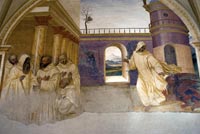
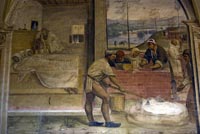
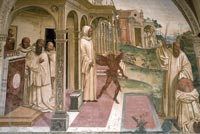
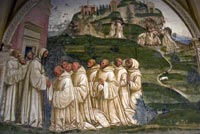
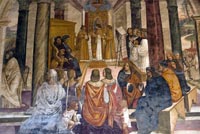
|
| |
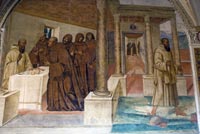 |
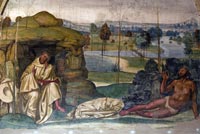 |
|
|
| |

|
|
|
Trequanda
|
|
|
| |
Leaving Monte Oliveto Maggiore and passing through San Giovanni d'Asso the route comes to Trequanda, an almost completely unknown hamlet and a real discovery. A perfectly preserved 13th-century castle dominates the few houses that there are with its cylindrical crenellated tower.
The church in the main Square, dedicated to Saints Peter and Andrew, is also 13th century and has a unique black and white stone checkerboard facade. Inside, there is a wonderful fresco of the Transfiguration by Sodoma.
|
|
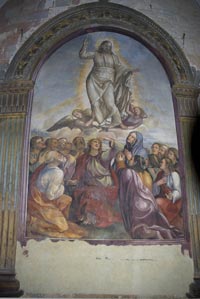
Sodoma, Transfiguration |
Abbadia Sant'Anna in Camprena
|
|
|
| |
On the road between Castelmuzio and Pienza, on a hill opposite the medieval fortress of Castelmuzio, the picturesque Abbey of Santa Anna in Camprena, founded in 1324 and successively reconstructed, is noted for its frescos by Giovanni Antonio Bazzi, known as Il Sodoma: the Multiplication of the Loaves and Fishes, on the entrance wall three scenes with an enthroned Saint Benedict surrounded by monks, the Pietà, the Madonna with Child, S. Anna and two Olivetan monks.
The six panels in the abbey refectory of Sant'Anna in Camprena tell the story of Christ and Maria. They represent the biblical miracle of the multiplication of the bread. La Pietà grieves over her son Jezus' crucifixion. In the multiplication of the bread, the painter lets the spectator enjoy the vast landscapes as if it were a snapshot of the city of Perugia. Important is that also Sant'Anna, the mother of the Virgin Mary and the woman after whom the monastery was named, can be admired on the frescoes. Anna (in Hebrew Hannah means grace) is the traditional name of the mother of the Blessed Virgin Mary. The Virgin Mary is often pictured reading or sewing. The lily symbolizes her virginity and purity.
Visiting hours of Monastery | Tuesday-Sunday: 15.30-19.30
|
|
|
| |
|
|
|
| |
|
|
|
|
|
|
![]()
![]()
![]()
![]()
![]()


 Il Sodoma, self portrait in one of the frescoes at Monte Olivetto
Il Sodoma, self portrait in one of the frescoes at Monte Olivetto
